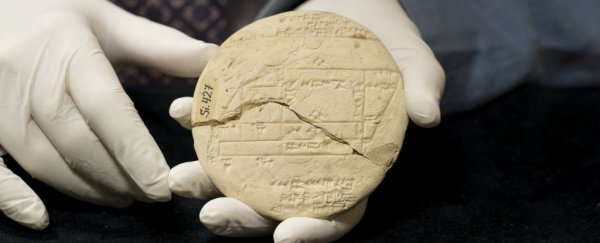An ancient fragment of clay tablet dating back to 3,700 years ago, during the Old Babylonian period, contains what is now the oldest known example of applied geometry, a mathematician has discovered. That's more than a millennium prior to the birth of Pythagoras.
And this history-altering artifact, known as Si.427, had just been sitting in a museum in Istanbul for more than 100 years.
"Si.427 dates from the Old Babylonian (OB) period - 1900 to 1600 BCE," said mathematician Daniel Mansfield of the University of New South Wales (UNSW) in Australia.
"It's the only known example of a cadastral document from the OB period, which is a plan used by surveyors to define land boundaries. In this case, it tells us legal and geometric details about a field that's split after some of it was sold off."
That plan uses sets of numbers known as Pythagorean triples to derive accurate right angles, or sets of numbers that fit trigonometric models for calculating the sides of a right-angled triangle. This makes the timing of the artifact particularly interesting, with important implications for the history of mathematics, Mansfield noted.
The discovery is described in a new paper that analyzes the context of this tablet with recent findings about a tablet contemporaneous with Si.427, known as Plimpton 322. In 2017, Mansfield and colleagues revealed that Plimpton 322 was an early trigonometric table, showing a whole list of Pythagorean triples.
At that time, the researchers did not know what the purpose of this list might be. Now, they think it might date to slightly later than Si.427, and contain only Pythagorean triples that would be relevant for making rectangular measurements of the ground. In other words, it's a planning manual.
This is in contrast to the trigonometry laid out by Pythagoras, which was devised by looking at the stars in the sky in the second century BCE. The number of Pythagorean triples that can be used for making land measurements by Babylonian surveyors is very small.
A Pythagorean triple fits the equation a2 + b2 = c2, where the sides defining a triangle that are adjacent to the right angle are a and b, and the hypotenuse (the longest side) is c. The simplest example would be 32 + 42 = 52.
 Animation showing the simplest example of Pythagorean triples. (AmericanXplorer13/Wikimedia/CC BY-SA 3.0)
Animation showing the simplest example of Pythagorean triples. (AmericanXplorer13/Wikimedia/CC BY-SA 3.0)
These sets of numbers can be used to draw triangles and rectangles with perfect right angles. But the sexagesimal, or base 60, Babylonian number system made it difficult to work with prime numbers larger than 5.
"This raises a very particular issue – their unique base 60 number system means that only some Pythagorean shapes can be used," Mansfield said.
"It seems that the author of Plimpton 322 went through all these Pythagorean shapes to find these useful ones. This deep and highly numerical understanding of the practical use of rectangles earns the name 'proto-trigonometry' but it is completely different to our modern trigonometry involving sin, cos, and tan."
Now, with Si.427, we finally know what they wanted to use these Pythagorean triples for - laying down land boundaries, according to Mansfield.
"This is from a period where land is starting to become private - people started thinking about land in terms of 'my land and your land', wanting to establish a proper boundary to have positive neighborly relationships," he explained.
"And this is what this tablet immediately says. It's a field being split, and new boundaries are made."
Other tablets from that time period reveal why this was so important. One regards a dispute over date palms on the border between two properties, in which the local administrator had agreed to dispatch a surveyor to settle the matter. It's easy to see why the ability to accurately measure out plots of land might have been important.
Nevertheless, it demonstrates a sophisticated understanding of geometry. It may not have been as advanced as the trigonometry later described by the ancient Greeks, but it does suggest that our understanding of mathematics may have been more incremental than current historical knowledge tells us.
"Nobody expected that the Babylonians were using Pythagorean triples in this way," Mansfield said. "It is more akin to pure mathematics, inspired by the practical problems of the time."
The research has been published in Foundations of Science.
